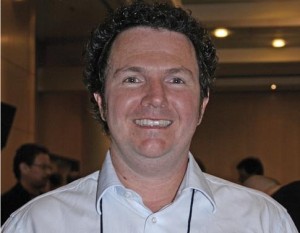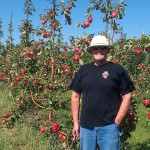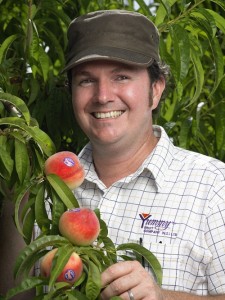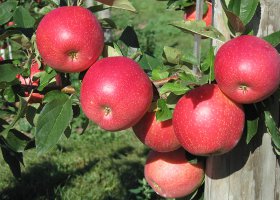SweeTango is on its way to going global.
The University of Minnesota, birthplace of SweeTango, told the world recently that the premium apple should be hitting markets outside North America in the coming years.
The story mentioned SweeTango apples becoming commercially available in New Zealand in 2014 and that the university is currently “working on commercial agreements that will enable companies to develop the Minneiska (the cultivar that produces SweeTango) variety in several countries, from South America to Switzerland.”
It’s exciting news, indeed. To bring you more of the story, we reached out to New Zealand grower, Paul Paynter, and boy did he have a story to tell.
Read Paynter’s witty and insightful tales below to learn why his family farm decided to take up growing the SweeTango, what the average New Zealander thinks of Americans and what the future holds for our appetizing apple in the land down under.

We own part of a company called Yummy Fruitthat imports and tests new fruit varieties. We get a steady stream of trees we put in a test block, some of which we know before they arrive and watch like a hawk, while others we’ve never heard of and they are largely ignored, short of an occasional munch to see if they are any good.
My father, John, now in his 70s, was wandering around down there, on the 17th of January 2008 to be exact. He noticed this apple that was red and fairly attractive, but what caught his eye is that the birds were into it like no apple he’d seen before. So he bit into one and said, “Wow!”
Now you don’t get a “wow” so easily from him. Having spent nearly 40 years of his life dealing with new varieties of fruit, he’s the grizzled old warrior. He was instrumental in pioneering lots of new stuff here and abroad, from Granny Smith and Gala to Pacific Rose and Jazz.
Anyway, he called me up for a taste and we threw some netting over the top to keep the birds at bay to let this mystery apple we only knew as “MN1914” ripen properly. We couldn’t believe how the birds continued to attack it even though it was high summer still and white fleshed nectarines with 18 brix (a measure of sugar content) were just a few flaps away.
So then we started doing our homework. Apparently they grow apples in Minnesota and have a university there with more than 100 years of apple breeding under their belt. This was news to us.

We hunted down Dennis Courtier from Pepin Heights at the Produce Marketing Association later that year and also made a visit to the University of Minnesota. Luckily for us, they decided that New Zealand would be a good prospect for their first commercialization of SweeTango outside North America. Three groups were vying for it, but thankfully Yummy and ENZA prevailed, signing a license in late 2010.
Then we only had 20 trees, but in two years at Yummy, we’ve turned that into about 70,000 trees–a pretty bold move seeing as we’re yet to grow a commercial crop of them here.
We’re growing SweeTango because it’s the most exciting apple we’ve seen and the biggest opportunity for our business here in New Zealand. We think it could change the way people think about apples and we really want to keep working with the guys from Minnesota.
We also like that it’s early season–the shelf is bare and this is exactly the apple we want to hit the consumer with first up. First impressions count and SweeTango certainly made a first impression on us. Why should it be different for the consumer? Every year we’d like their first impressions of the new season’s crop to be the same “wow” my father experienced.

How long have you been an apple grower?
The Paynter famly arrived in New Zealand in 1841 and started growing apples around 1870 in Stoke, near Nelson — that’s in the stunning south island. We then moved up to Hawkes Bayin the warmer north, because there were no people in the south island. I think they have cracked 1 million down there now, but people still wave when you pass them in a car because it might be the only human contact they get for a while.
So I’m a fifth generation grower. We have had lots of interest from corporations wanting to invest over the years, but we like being a family business and having family values. Although the payroll never really drops below 200 staff these days, we’re still a hayseed farming family at heart and proud of it. There are no plans to change that.
My father once said, “We’re not in this business to make money,” and that’s the truth of it. We love what we do and feel like we’re feeding people real, good and really good food. The financial rewards are modest, but so are our needs, so that works.
What’s the history of your growing operation?
The parent company is Johnny Appleseed Holdings Ltd. Yummy is our brand and what most people know us by. Not too many people have heard of Johnny Appleseed over here. The neighbor told us he was going to change his name to “Peter Pear Picker” when he first heard the name. But we really like the story of Johnny Appleseed a lot and certainly share his passion for planting apple trees. My father has planted maybe 5,000 acres in his career, which is a lot in a tiny country.
We think inte-rgenerationally, if that is a word, because you can’t make it in fruit growing in 20 years without each generation taking the base laid down by the last, and then taking it to the next level. Farming is like any other business; if you stand still, you’ll get run over. You have to keep making progress on better apples, better technology, better growing systems, better storage techniques, better packaging, better marketing.
What’s your growing environment like and how would you describe New Zealand to those unfamiliar?
In some parts it’s just like “Lord of the Rings,” but without the hobbits. It’s a beautiful country a million miles from anywhere.
If you asked 20 people in the U.S. to point us out on a map, I would bet most would get it wrong. Many think we’re part of Australia, but they are about 1,500 miles away and very different. For us, it’s like saying British Columbia is part of Texas; we can instantly pick the difference in accent and culture between New Zealand and Australia.
Most people get their idea about America from your politicians and from Hollywood and so we sensibly conclude you’re all completely mad. Certainly we think you’re very different to us. We have no one like the Kardashians here.
For the lucky, like me, who travel to the U.S. most years, there doesn’t seem to be so many differences. The average guy in the U.S. is battling with the same things as the average guy in New Zealand — mowing the lawns on the weekend, hoping his job is safe and trying to keep his kids on the straight and narrow.
Traveling makes all the cultural differences go away. The people in Turkey or China aren’t so different either. We feel really at home in the U.S., particularly in small towns like the one we live in. The U.S. is the land of “you’re welcome” (we don’t really say that here, opting for a “no worries, mate”). Once you get past immigration, you do feel incredibly welcome in the U.S. and mostly it’s full of kind and generous people. We have been on the receiving end of some pretty amazing U.S. hospitality.
Also we get to rent big ol’ American cars over there and drive on the wrong side of the road. It’s great fun! Come over here, get a teeny weeny car and drive on the left side of the road and you’ll know what I mean.
How is it similar and/or different growing where you are than growing in North America?
The apple trees are the same everywhere, but the climate is very different. Everyone is surprised how well Sweetango grows here as it’s nothing like Minnesota.
We are a wine growing region and the weather here is probably much like that in the Napa Valley. It hasn’t snowed here for more than 80 years, but we get a few hard frosts. We also have the most unbelievable alluvial soils here, produced by thousands of years of flooding. Some of our orchards have eight feet of topsoil. We’re also lucky to have large aquifers here so water is easy to come by.
The main problem with growing here is that we’re an island in the Pacific Ocean and once in a while we can get some pretty wild weather. We are protected by mountains here on the east coast, but still we can get the remnants of a tropical cyclone sometimes.
What is the best thing about living where you do?
New Zealand is a backwater, and Hawkes Bay is a backwater of a backwater.
It’s peaceful, modestly populated (4 million people nationally), has every landscape you can think of and it’s a totally unpretentious country. We are nobodies and proud of it.
If you like the outdoors, this is paradise — but bring a raincoat. Also the food and wine is great here, and the coffee. Those guys on “Flight of the Conchords” are a pretty accurate reflection of the Kiwi persona — quirky, naïve and mildly amusing.
What is the worst thing?
The worst thing about New Zealand is the same as it is in the U.S., or anywhere rather — small-minded, ill-educated people who know nothing but what they see every day. Our problem is we’re so far from the rest of the world that it’s too expensive to travel, and in the U.S., it’s that you don’t get enough vacation time and so can’t travel so much to see and learn about other cultures.
 How would you describe the SweeTango to someone who had never tasted it?
How would you describe the SweeTango to someone who had never tasted it?
I’d rather just give them one and see how they react!
For me, though, the most amazing thing about the apple the first time I tasted it was the texture. The cell size in the flesh is huge and they pop like nothing else when you sink your teeth in, which makes Sweetango super light and refreshing. It’s hard to explain why something is “Wow!” It’s just “Wow!” Try one and you’ll understand exactly what I’m saying.
Is the SweeTango the best apple you’ve ever had? Why or why not?
Yep. It’s the best and most exciting apple I’ve tried — and I’ve tried 500 or so from the best breeding programs in the world. How this came out of a small program in Minnesota, I really can’t fathom. I suppose it’s like a lottery and they hit the jackpot.
We’ve planted a few new varieties in our time, but never so many, so fast, so madly as the SweeTango!
Photo of Paul Paynter courtesy Good Fruit Grower.